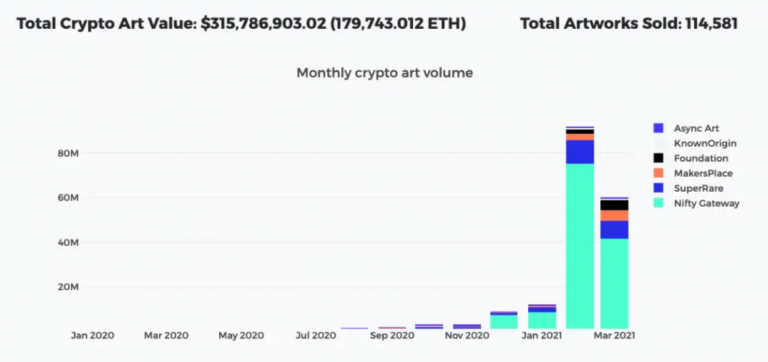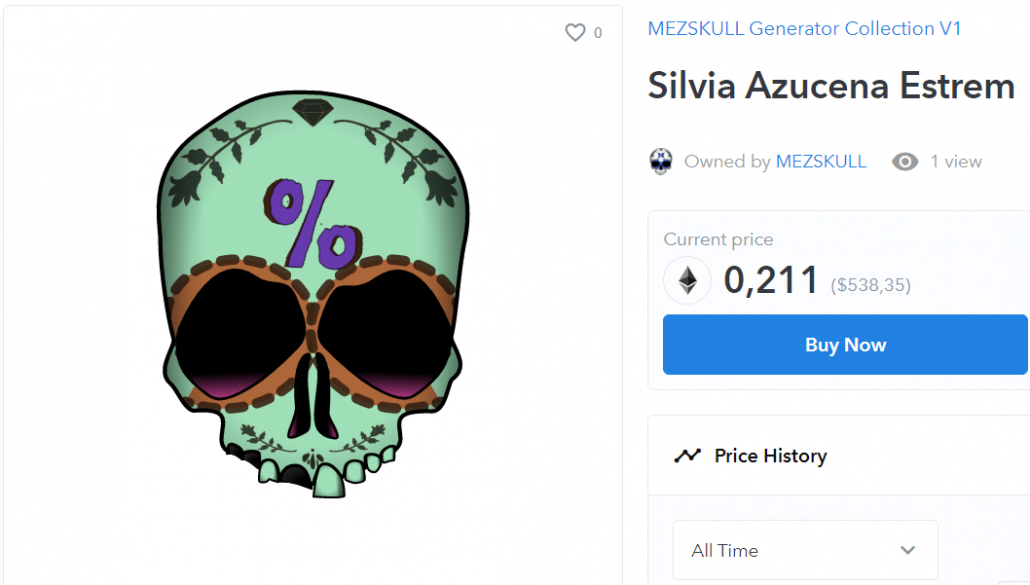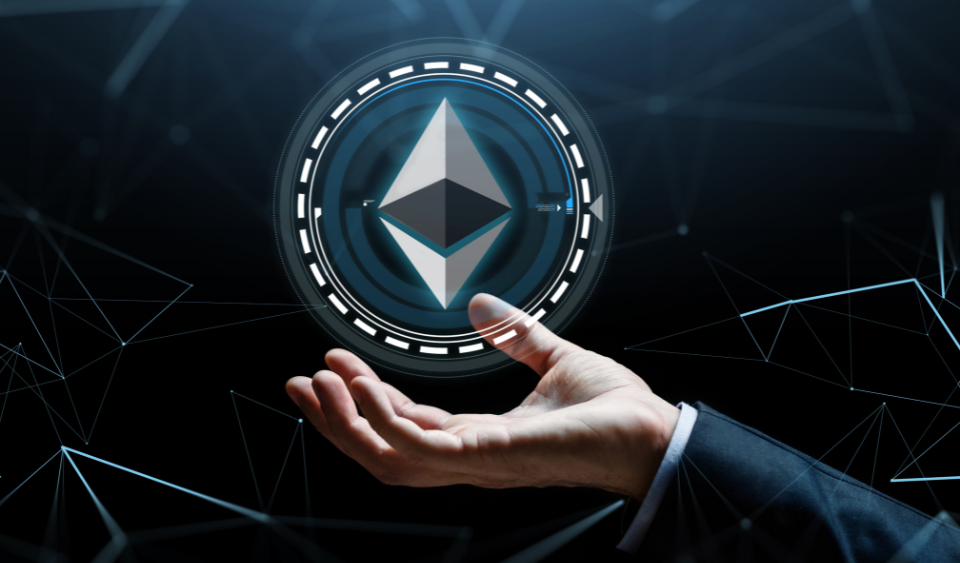How blockchain is reshaping the art world

Ever since the Bitcoin Genesis Block was released on January 3, 2009, blockchain technology has underpinned major developments in cryptocurrencies. But when Christie’s completed the sale of the Barney A. Ebsworth Collection entirely on the blockchain in November, 2018, fetching a record sum of nearly $318 million, the technology announced its arrival onto the art scene.
Blockchain is a distributed ledger technology (DLT) that’s primed to resolve many of the issues that have plagued the art industry ever since the Romans began auctioning off their war booty. Namely issues connected with provenance, ownership, transparency, copyright, and forgery.
The global blockchain market size is expected to grow from $3 billion in 2020 to $39.7 billion by 2025, an impressive CAGR of 67.3%. But it’s also set to shake up the art market traditionally dominated by powerful art collectors and dealers, opening up access to artworks and making the whole process more transparent.
In this article, we’ll explore how blockchain technology will drive many exciting innovations in the art world.
The current state of the art market
The Art Market is an annual report that provides an independent analysis of the global art market. It made several interesting findings:
- Although the global art market dipped 22%, online sales reached a record $12.4 billion. Online sales captured an unprecedented 25% of market share, up from just 9% the previous year. This surpassed **sales from brick-and-mortar galleries.
- Auction house sales rose 36% online while public sales dropped 30%.
- In fine art 22% of the lots sold were through online-only sales.
- High Net Worth collectors showed considerable willingness to adapt to online viewing rooms (OVRs). Nearly half (45%) made purchases this way.
- One third of collectors purchased art using Instagram.
- Works with visible prices generated 92% of enquiries on their OVRs showing the importance of transparency.
- Millennials are showing a growing interest in collecting art with 38% spending more than $1 million.
The growing interest from the digitally aware millennial generation is significant because it marks a crossroads in the art industry. They, more than anyone, know the benefits of peer-to-peer technology (P2P) which eliminates middlemen and improves trust. Blockchain, as a facilitator of peer-to-peer technology, is increasing efficiencies for auction houses and dealers.
Art auctions have traditionally been the preserve of the elite. The major houses like Sotheby’s and Christie’s have been dealing with wealthy collectors for centuries. But forgeries are eroding trust in the art industry. Further, artists are not fully compensated for their work.
There’s a golden opportunity for blockchain to rescue the art industry. It increases transparency while enabling cost efficiencies in the buying process.

Source: https://magazine.artland.com/how-the-crypto-art-boom-is-changing-the-art-market/
Let’s explore how blockchain technology is reshaping the art industry.
How blockchain is reshaping the art industry
As we mentioned earlier, the art industry is beset by issues connected to provenance, ownership, transparency, copyright, and fraud. And only the privileged few can access art.
Amidst the unique requirements of the art industry, blockchain technology is revolutionising the way art is created, bought and sold. It may seem like the age-old traditions embodied by the likes of Sotheby’s won’t pair well with distributed ledger technologies but, if the art industry is to survive the 21st century, it needs to embrace its technological innovations. Blockchain technology will be the difference between success and failure in the art industry.
Blockchain proves the provenance of art
Proving the provenance of a piece of art is a crucial step in the valuation process. Thomas Hoving, a former director at the Metropolitan Museum of Art in New York, famously estimated that 40% of works on sale are fake. In 2011, America’s oldest gallery, Knoedler, ceased trading following allegations it sold works wrongly attributed to artists such as Jackson Pollock and Robert Motherwell.
Blockchain keeps an immutable record of transactions as it relates to a piece of art. Once you add a block of data to the blockchain, it cannot be altered. Since there’s no centralised storage of data (it’s distributed among thousands of computers), it would require a mathematically impossible amount of computing power to alter any information. Blockchain provides an indelible record of ownership. Art collectors and dealers can unambiguously trace the ownership of a piece of art right back to the original artist. It would be impossible to manipulate an artwork’s value.
Blockchain makes art more accessible
We’ve discussed how the art market’s been under the influence of wealthy collectors and dealers. Blockchain removes the middlemen and allows the artist to sell directly to the seller, circumventing inflated fees. This gives artists the freedom to control their prices and avoid the whims of gatekeepers. Art collectors can equally access original works of art and be sure of their authenticity, again without relying on middlemen.
It’s straightforward to securitise works of art with blockchain. It’s becoming increasingly popular to buy shares in works of art. It’s far less risky than investing in complete works of art and, much like traditional securities, it’s easy to transfer ownership.
It also used to be that, not only you were restricted by the size of your bank account, but you were also limited by your geographical location. Unless you could access the right galleries and dealers, you couldn’t acquire art. Blockchain eliminates this restriction.
A decentralised global system eliminates fees and ensures that more people, wherever they’re located, can access works of art.
Furthermore, blockchain records – embedded with smart contracts – enable artists to track their artwork as it’s bought and sold and earn royalties from it.
Blockchain decentralises authority
Pascal Boyart is a French crypto artist who pioneered the use of QR codes in artwork to encourage donations. In 2019, he commemorated the 10th anniversary of the Bitcoin Genesis Block with a mural. The Paris authorities smothered his commemoration and painted over the mural. The mural was promptly recreated on the blockchain, immortalising it in crypto space. Thus, censorship was circumvented. In fact, fragments of the mural can now be bought in the OpenSea marketplace.
With no centralised authority controlling the creation, buying or selling of art, art lovers are free to buy and sell artwork quickly and conveniently. Bids can be placed anywhere in the world and smart contracts process the transactions seamlessly. As soon as funds are received – an automatic process with smart contracts – the buyer receives their piece of art and has a complete record of ownership.
Cryptocurrencies are naturally suited to these transactions. You can transfer funds instantly and circumvent the fees associated with traditional banking.
Blockchain reproduces physical art
Blockchain makes it possible to reproduce physical works of art on high-definition displays and screens. It does this by recording digital files and tracing their provenance to the original artist.
Fashion designers face unique challenges in protecting their intellectual property. They could also benefit from blockchain technology. It helps them trace the origins of materials and use multiple forms of intellectual property to protect their designs.
What’s digital art (NFT)?
Non-Fungible Tokens (NFT’s) first gained public awareness in 2017 with games like CryptoKitties. This crypto game allows players to breed, collect, purchase, and sell virtual cats. Fungibility is an economic concept which denotes the ability of a good or asset to be substituted for another of identical specification. Money is fungible – one Euro can be substituted for one hundred cents. A classic car owned by a celebrity is non-fungible. It cannot be substituted. Likewise, Non-Fungible Tokens cannot be substituted. They represent unique works of art, physical or digital. They’re recorded on the blockchain. They encapsulate the provenance of a work of art and conditions of its transfer.
Tokenisation is the process of issuing a digital token on the blockchain. It’s a unique string of numbers that represents a physical or digital asset. Tokens (including NFT’s) cannot be copied or altered once recorded on the blockchain. But they can be transferred to another person.
Christie’s was the first major auction house to offer a fully digital work of art for sale when it issued an NFT for Beeple’s Everydays: The First 5,000 Days on March 11, 2021, fetching over $69 million. In March 2021 Canadian musician Grimes sold $6 million worth of NFT’s, pledging to donate a portion to Carbon180, a non-profit committed to reducing carbon emissions. In the same month, Twitter founder Jack Dorsey auctioned off his first ever tweet as an NFT for over $2.9 million.

The cat’s now out of the bag and platforms like SuperRare and Rarible allow artists to tokenise and trade their artwork. If you’re interested, we’ve set up the Mezskull project, a random generator of skulls, each one unique and unrepeatable and created by a mathematical algorithm. These skulls are currently available for purchase on Opensea.
Final thoughts
Blockchain technology has come a long way since the release of the Bitcoin Genesis Block. Because of its ability to record transactions transparently and immutably, blockchain is the perfect platform for art lovers to buy and sell artwork. They’re safe knowing that its authenticity will be recognised and rewarded.
Contacts:
+39 02 45391390




